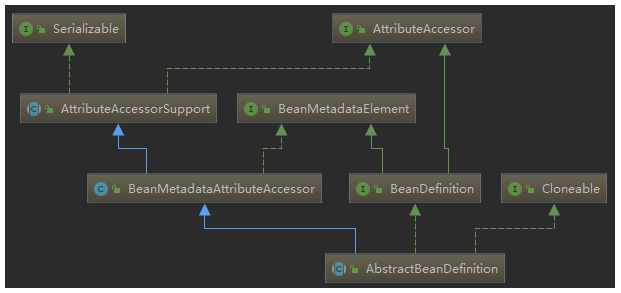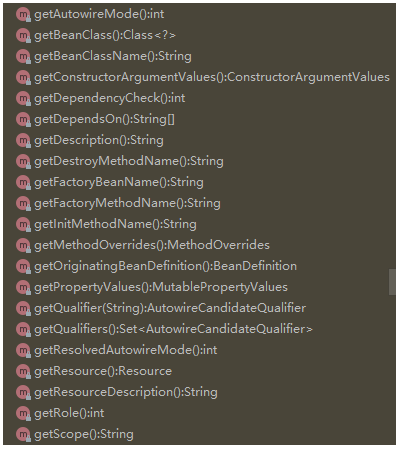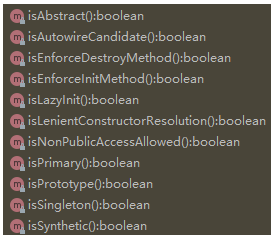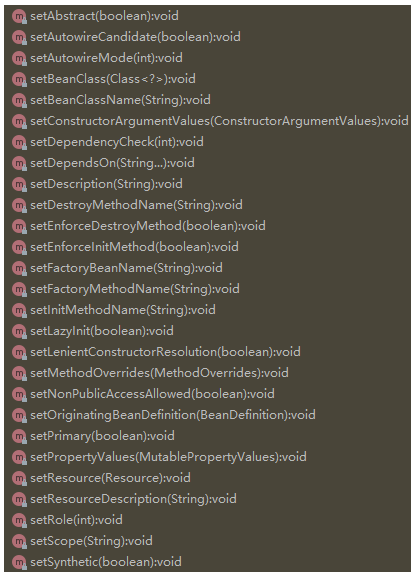前言:Spring源码学习-AbstractBeanDefinition
简介 AbstractBeanDefinition继承了BeanMetadataAttributeAccessor类,实现了BeanDefinition与Cloneable接口,类图如下
AbstractBeanDefinition中定义了很多bean的属性,另外也实现BeanDefinition接口方法
PS:AbstractBeanDefinition中的方法基本都是get/set/is方法
属性 1 2 3 4 5 6 7 8 9 10 11 12 13 14 15 16 17 18 19 20 21 22 23 24 25 26 27 28 29 30 31 32 33 34 35 36 37 38 39 40 41 42 43 44 45 46 47 48 49 50 51 52 53 54 55 56 57 58 59 60 61 62 63 64 65 66 67 68 69 70 71 72 73 74 75 76 77 78 79 80 81 82 83 84 85 86 87 88 89 90 91 92 93 94 95 96 97 98 99 100 101 102 103 104 105 106 107 108 public static final String SCOPE_DEFAULT = "" ;public static final int AUTOWIRE_NO = AutowireCapableBeanFactory.AUTOWIRE_NO;public static final int AUTOWIRE_BY_NAME = AutowireCapableBeanFactory.AUTOWIRE_BY_NAME;public static final int AUTOWIRE_BY_TYPE = AutowireCapableBeanFactory.AUTOWIRE_BY_TYPE;public static final int AUTOWIRE_CONSTRUCTOR = AutowireCapableBeanFactory.AUTOWIRE_CONSTRUCTOR;@Deprecated public static final int AUTOWIRE_AUTODETECT = AutowireCapableBeanFactory.AUTOWIRE_AUTODETECT;public static final int DEPENDENCY_CHECK_NONE = 0 ;public static final int DEPENDENCY_CHECK_OBJECTS = 1 ;public static final int DEPENDENCY_CHECK_SIMPLE = 2 ;public static final int DEPENDENCY_CHECK_ALL = 3 ;public static final String INFER_METHOD = "(inferred)" ;private volatile Object beanClass;private String scope = SCOPE_DEFAULT;private boolean abstractFlag = false ;private boolean lazyInit = false ;private int autowireMode = AUTOWIRE_NO;private int dependencyCheck = DEPENDENCY_CHECK_NONE;private String[] dependsOn;private boolean autowireCandidate = true ;private boolean primary = false ;private final Map<String, AutowireCandidateQualifier> qualifiers = new LinkedHashMap<String, AutowireCandidateQualifier>(0 ); private boolean nonPublicAccessAllowed = true ;private boolean lenientConstructorResolution = true ;private String factoryBeanName;private String factoryMethodName;private ConstructorArgumentValues constructorArgumentValues;private MutablePropertyValues propertyValues;private MethodOverrides methodOverrides = new MethodOverrides();private String initMethodName;private String destroyMethodName;private boolean enforceInitMethod = true ;private boolean enforceDestroyMethod = true ;private boolean synthetic = false ;private int role = BeanDefinition.ROLE_APPLICATION;private String description;private Resource resource;
构造方法 PS:抽象类的构造方法由子类调用
使用默认设置创建新的AbstractBeanDefinition。
1 2 3 protected AbstractBeanDefinition () this (null , null ); }
使用给定的构造函数参数值和属性值创建新的AbstractBeanDefinition
1 2 3 4 protected AbstractBeanDefinition (ConstructorArgumentValues cargs, MutablePropertyValues pvs) setConstructorArgumentValues(cargs); setPropertyValues(pvs); }
通过给定的BeanDefinition创建新的AbstractBeanDefinition
1 2 3 4 5 6 7 8 9 10 11 12 13 14 15 16 17 18 19 20 21 22 23 24 25 26 27 28 29 30 31 32 33 34 35 36 37 38 39 40 41 42 43 44 45 protected AbstractBeanDefinition (BeanDefinition original) setParentName(original.getParentName()); setBeanClassName(original.getBeanClassName()); setScope(original.getScope()); setAbstract(original.isAbstract()); setLazyInit(original.isLazyInit()); setFactoryBeanName(original.getFactoryBeanName()); setFactoryMethodName(original.getFactoryMethodName()); setConstructorArgumentValues(new ConstructorArgumentValues(original.getConstructorArgumentValues())); setPropertyValues(new MutablePropertyValues(original.getPropertyValues())); setRole(original.getRole()); setSource(original.getSource()); copyAttributesFrom(original); if (original instanceof AbstractBeanDefinition) { AbstractBeanDefinition originalAbd = (AbstractBeanDefinition) original; if (originalAbd.hasBeanClass()) { setBeanClass(originalAbd.getBeanClass()); } setAutowireMode(originalAbd.getAutowireMode()); setDependencyCheck(originalAbd.getDependencyCheck()); setDependsOn(originalAbd.getDependsOn()); setAutowireCandidate(originalAbd.isAutowireCandidate()); setPrimary(originalAbd.isPrimary()); copyQualifiersFrom(originalAbd); setNonPublicAccessAllowed(originalAbd.isNonPublicAccessAllowed()); setLenientConstructorResolution(originalAbd.isLenientConstructorResolution()); setMethodOverrides(new MethodOverrides(originalAbd.getMethodOverrides())); setInitMethodName(originalAbd.getInitMethodName()); setEnforceInitMethod(originalAbd.isEnforceInitMethod()); setDestroyMethodName(originalAbd.getDestroyMethodName()); setEnforceDestroyMethod(originalAbd.isEnforceDestroyMethod()); setSynthetic(originalAbd.isSynthetic()); setResource(originalAbd.getResource()); } else { setResourceDescription(original.getResourceDescription()); } }
addQualifier
1 2 3 public void addQualifier (AutowireCandidateQualifier qualifier) this .qualifiers.put(qualifier.getTypeName(), qualifier); }
addQualifier 新增限定符
1 2 3 public void addQualifier (AutowireCandidateQualifier qualifier) this .qualifiers.put(qualifier.getTypeName(), qualifier); }
applyDefaults 根据参数提供的默认值设置当前对象相应属性
1 2 3 4 5 6 7 8 9 public void applyDefaults (BeanDefinitionDefaults defaults) setLazyInit(defaults.isLazyInit()); setAutowireMode(defaults.getAutowireMode()); setDependencyCheck(defaults.getDependencyCheck()); setInitMethodName(defaults.getInitMethodName()); setEnforceInitMethod(false ); setDestroyMethodName(defaults.getDestroyMethodName()); setEnforceDestroyMethod(false ); }
clone clone方法需要子类重写
1 2 3 4 @Override public Object clone () return cloneBeanDefinition(); }
1 public abstract AbstractBeanDefinition cloneBeanDefinition ()
copyQualifiersFrom 将参数AbstractBeanDefinition中的限定符复制到此bean定义
1 2 3 4 public void copyQualifiersFrom (AbstractBeanDefinition source) Assert.notNull(source, "Source must not be null" ); this .qualifiers.putAll(source.qualifiers); }
equals 下面重写了hashCode方法,所以要重写equals方法,顺便一提,bean在解析后被存放在一个HashMap中
1 2 3 4 5 6 7 8 9 10 11 12 13 14 15 16 17 18 19 20 21 22 23 24 25 26 27 28 29 30 31 32 33 34 35 36 37 38 39 40 41 @Override public boolean equals (Object other) if (this == other) { return true ; } if (!(other instanceof AbstractBeanDefinition)) { return false ; } AbstractBeanDefinition that = (AbstractBeanDefinition) other; if (!ObjectUtils.nullSafeEquals(getBeanClassName(), that.getBeanClassName())) return false ; if (!ObjectUtils.nullSafeEquals(this .scope, that.scope)) return false ; if (this .abstractFlag != that.abstractFlag) return false ; if (this .lazyInit != that.lazyInit) return false ; if (this .autowireMode != that.autowireMode) return false ; if (this .dependencyCheck != that.dependencyCheck) return false ; if (!Arrays.equals(this .dependsOn, that.dependsOn)) return false ; if (this .autowireCandidate != that.autowireCandidate) return false ; if (!ObjectUtils.nullSafeEquals(this .qualifiers, that.qualifiers)) return false ; if (this .primary != that.primary) return false ; if (this .nonPublicAccessAllowed != that.nonPublicAccessAllowed) return false ; if (this .lenientConstructorResolution != that.lenientConstructorResolution) return false ; if (!ObjectUtils.nullSafeEquals(this .constructorArgumentValues, that.constructorArgumentValues)) return false ; if (!ObjectUtils.nullSafeEquals(this .propertyValues, that.propertyValues)) return false ; if (!ObjectUtils.nullSafeEquals(this .methodOverrides, that.methodOverrides)) return false ; if (!ObjectUtils.nullSafeEquals(this .factoryBeanName, that.factoryBeanName)) return false ; if (!ObjectUtils.nullSafeEquals(this .factoryMethodName, that.factoryMethodName)) return false ; if (!ObjectUtils.nullSafeEquals(this .initMethodName, that.initMethodName)) return false ; if (this .enforceInitMethod != that.enforceInitMethod) return false ; if (!ObjectUtils.nullSafeEquals(this .destroyMethodName, that.destroyMethodName)) return false ; if (this .enforceDestroyMethod != that.enforceDestroyMethod) return false ; if (this .synthetic != that.synthetic) return false ; if (this .role != that.role) return false ; return super .equals(other); }
get方法 不具体分析,获取相应的属性,属性详情见上文
hasBeanClass 是否指定bean类
1 2 3 public boolean hasBeanClass () return (this .beanClass instanceof Class); }
hasConstructorArgumentValues 此bean定义的构造函数参数值是否为空
1 2 3 public boolean hasConstructorArgumentValues () return !this .constructorArgumentValues.isEmpty(); }
hashCode 返回该对象哈希码
1 2 3 4 5 6 7 8 9 10 11 @Override public int hashCode () int hashCode = ObjectUtils.nullSafeHashCode(getBeanClassName()); hashCode = 29 * hashCode + ObjectUtils.nullSafeHashCode(this .scope); hashCode = 29 * hashCode + ObjectUtils.nullSafeHashCode(this .constructorArgumentValues); hashCode = 29 * hashCode + ObjectUtils.nullSafeHashCode(this .propertyValues); hashCode = 29 * hashCode + ObjectUtils.nullSafeHashCode(this .factoryBeanName); hashCode = 29 * hashCode + ObjectUtils.nullSafeHashCode(this .factoryMethodName); hashCode = 29 * hashCode + super .hashCode(); return hashCode; }
hasQualifier 返回此bean是否具有指定的限定符
1 2 3 public boolean hasQualifier (String typeName) return this .qualifiers.keySet().contains(typeName); }
is方法 不具体分析,获取布尔类型属性,属性详情见上文
overrideFrom 类似构造方法,通过给定的BeanDefinition参数,重新设置此bean定义的属性
1 2 3 4 5 6 7 8 9 10 11 12 13 14 15 16 17 18 19 20 21 22 23 24 25 26 27 28 29 30 31 32 33 34 35 36 37 38 39 40 41 42 43 44 45 46 47 48 49 50 51 52 53 54 55 56 public void overrideFrom (BeanDefinition other) if (StringUtils.hasLength(other.getBeanClassName())) { setBeanClassName(other.getBeanClassName()); } if (StringUtils.hasLength(other.getScope())) { setScope(other.getScope()); } setAbstract(other.isAbstract()); setLazyInit(other.isLazyInit()); if (StringUtils.hasLength(other.getFactoryBeanName())) { setFactoryBeanName(other.getFactoryBeanName()); } if (StringUtils.hasLength(other.getFactoryMethodName())) { setFactoryMethodName(other.getFactoryMethodName()); } getConstructorArgumentValues().addArgumentValues(other.getConstructorArgumentValues()); getPropertyValues().addPropertyValues(other.getPropertyValues()); setRole(other.getRole()); setSource(other.getSource()); copyAttributesFrom(other); if (other instanceof AbstractBeanDefinition) { AbstractBeanDefinition otherAbd = (AbstractBeanDefinition) other; if (otherAbd.hasBeanClass()) { setBeanClass(otherAbd.getBeanClass()); } setAutowireMode(otherAbd.getAutowireMode()); setDependencyCheck(otherAbd.getDependencyCheck()); setDependsOn(otherAbd.getDependsOn()); setAutowireCandidate(otherAbd.isAutowireCandidate()); setPrimary(otherAbd.isPrimary()); copyQualifiersFrom(otherAbd); setNonPublicAccessAllowed(otherAbd.isNonPublicAccessAllowed()); setLenientConstructorResolution(otherAbd.isLenientConstructorResolution()); getMethodOverrides().addOverrides(otherAbd.getMethodOverrides()); if (StringUtils.hasLength(otherAbd.getInitMethodName())) { setInitMethodName(otherAbd.getInitMethodName()); setEnforceInitMethod(otherAbd.isEnforceInitMethod()); } if (otherAbd.getDestroyMethodName() != null ) { setDestroyMethodName(otherAbd.getDestroyMethodName()); setEnforceDestroyMethod(otherAbd.isEnforceDestroyMethod()); } setSynthetic(otherAbd.isSynthetic()); setResource(otherAbd.getResource()); } else { setResourceDescription(other.getResourceDescription()); } }
prepareMethodOverride 由prepareMethodOverrides方法调用,验证并准备给定的方法重载。检查指定名称的方法是否存在,如果没有找到方法,则将其标记为未重载。
1 2 3 4 5 6 7 8 9 10 11 12 13 14 15 16 protected void prepareMethodOverride (MethodOverride mo) throws BeanDefinitionValidationException int count = ClassUtils.getMethodCountForName(getBeanClass(), mo.getMethodName()); if (count == 0 ) { throw new BeanDefinitionValidationException( "Invalid method override: no method with name '" + mo.getMethodName() + "' on class [" + getBeanClassName() + "]" ); } else if (count == 1 ) { mo.setOverloaded(false ); } }
prepareMethodOverrides prepareMethodOverrides方法循环调用了prepareMethodOverride方法,验证方法重写
1 2 3 4 5 6 7 8 9 10 11 public void prepareMethodOverrides () throws BeanDefinitionValidationException MethodOverrides methodOverrides = getMethodOverrides(); if (!methodOverrides.isEmpty()) { Set<MethodOverride> overrides = methodOverrides.getOverrides(); synchronized (overrides) { for (MethodOverride mo : overrides) { prepareMethodOverride(mo); } } } }
resolveBeanClass 1 2 3 4 5 6 7 8 9 public Class<?> resolveBeanClass(ClassLoader classLoader) throws ClassNotFoundException { String className = getBeanClassName(); if (className == null ) { return null ; } Class<?> resolvedClass = ClassUtils.forName(className, classLoader); this .beanClass = resolvedClass; return resolvedClass; }
set方法 也不具体分析,设置相应的属性,属性详情见上文
toString 对象转字符串,基本上就是拼接AbstractBeanDefinition的一些属性输出
1 2 3 4 5 6 7 8 9 10 11 12 13 14 15 16 17 18 19 20 @Override public String toString () StringBuilder sb = new StringBuilder("class [" ); sb.append(getBeanClassName()).append("]" ); sb.append("; scope=" ).append(this .scope); sb.append("; abstract=" ).append(this .abstractFlag); sb.append("; lazyInit=" ).append(this .lazyInit); sb.append("; autowireMode=" ).append(this .autowireMode); sb.append("; dependencyCheck=" ).append(this .dependencyCheck); sb.append("; autowireCandidate=" ).append(this .autowireCandidate); sb.append("; primary=" ).append(this .primary); sb.append("; factoryBeanName=" ).append(this .factoryBeanName); sb.append("; factoryMethodName=" ).append(this .factoryMethodName); sb.append("; initMethodName=" ).append(this .initMethodName); sb.append("; destroyMethodName=" ).append(this .destroyMethodName); if (this .resource != null ) { sb.append("; defined in " ).append(this .resource.getDescription()); } return sb.toString(); }
validate 校验当前对象
1 2 3 4 5 6 7 8 9 10 11 12 public void validate () throws BeanDefinitionValidationException if (!getMethodOverrides().isEmpty() && getFactoryMethodName() != null ) { throw new BeanDefinitionValidationException( "Cannot combine static factory method with method overrides: " + "the static factory method must create the instance" ); } if (hasBeanClass()) { prepareMethodOverrides(); } }
总结 总的来说,AbstractBeanDefinition实现了BeanDefinition接口的方法,定义了Bean的描述信息(例如是否是抽象类、是否单例)、depends-on属性(String类型,不是Class类型)、自动装配的相关信息、init函数、destroy函数的名字(String类型)、工厂方法名、工厂类名(String类型,不是Class类型)、构造函数形参的值、被IOC容器覆盖的方法、Bean的属性以及对应的值(在初始化后会进行填充)等一系列属性,同时这是一个抽象类,基于该类,可以进一步封装



